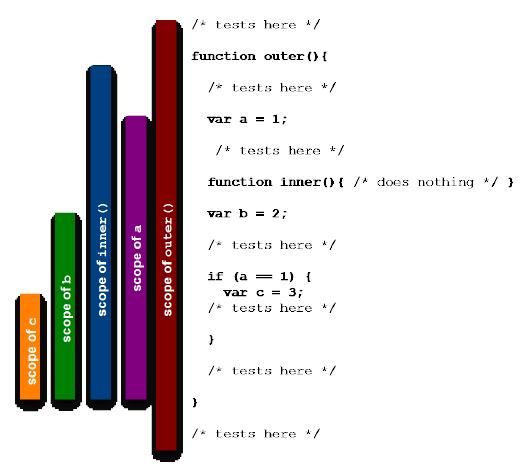Secrets of the JavaScript Ninja - 1
日期:2014-05-16 浏览次数:20434 次
Secrets of the JavaScript Ninja -- 1
Chapter 3
Scoping and functions
Scoping rules in Javascript:
1. Variable declarations are in scope from their point of declaration to the end of the function within which they are declared, regardless of block nesting.
Look at this example:
if(window){
var x = 13;
}
alert(x); // 13
2. Named functions are in scope within the entire function within which they are declared, regardless of block nesting.
function outer {
alert(typeof inner === 'function', "inner() in scope before declaration");
function inner() { return "inner";}
alert(typeof inner === 'function', "inner() in scope after declaration");
}
3. For the purposes of declaration scopes, the global context acts like one big function encompassing the code on the page.
And for the code snippet below, what's the scope for each function and variable?
Answer:

Invocations
There are actually four different ways to invoke a function, each with their own nuances.
They are:
1. As a function, in which the function is invoked in a straightforward manner.
2. As a method, which ties the invocation to an object, enabling object-oriented
programming.
3. As a constructor, in which a new object is brought into being.
4. Via their apply() or call() methods
Difference between 1 & 2:
When using 2, *this* scope is the caller.
How is 3 implemented?
Invoking a function as a constructor is a powerful feature of JavaScript because when a
constructor is invoked, the following special actions take place:
? A new empty object is created.
? This object is passed to the constructor as the this parameter, and thus becomes the
constructor’s function context.
? In the absence of any explicit return value, the new object is returned as the
constructor’s value.
Summary:
o When invoked as a simple function, the context is the global object
(window).
o When invoked as a method, the context is the object owning the method.
o When invoked as a constructor, the context is a newly allocated object.
o When invoked via the apply() or call() methods of the function, the
context can be whatever the heck we want.
Chapter 3
Scoping and functions
Scoping rules in Javascript:
1. Variable declarations are in scope from their point of declaration to the end of the function within which they are declared, regardless of block nesting.
Look at this example:
if(window){
var x = 13;
}
alert(x); // 13
2. Named functions are in scope within the entire function within which they are declared, regardless of block nesting.
function outer {
alert(typeof inner === 'function', "inner() in scope before declaration");
function inner() { return "inner";}
alert(typeof inner === 'function', "inner() in scope after declaration");
}
3. For the purposes of declaration scopes, the global context acts like one big function encompassing the code on the page.
And for the code snippet below, what's the scope for each function and variable?
function outer(){
var a = 1;
function inner(){ /* does nothing */ }
var b = 2;
if (a == 1) {
var c = 3;
}
}
outer();
Answer:

Invocations
There are actually four different ways to invoke a function, each with their own nuances.
They are:
1. As a function, in which the function is invoked in a straightforward manner.
2. As a method, which ties the invocation to an object, enabling object-oriented
programming.
3. As a constructor, in which a new object is brought into being.
4. Via their apply() or call() methods
Difference between 1 & 2:
When using 2, *this* scope is the caller.
How is 3 implemented?
Invoking a function as a constructor is a powerful feature of JavaScript because when a
constructor is invoked, the following special actions take place:
? A new empty object is created.
? This object is passed to the constructor as the this parameter, and thus becomes the
constructor’s function context.
? In the absence of any explicit return value, the new object is returned as the
constructor’s value.
Summary:
o When invoked as a simple function, the context is the global object
(window).
o When invoked as a method, the context is the object owning the method.
o When invoked as a constructor, the context is a newly allocated object.
o When invoked via the apply() or call() methods of the function, the
context can be whatever the heck we want.
免责声明: 本文仅代表作者个人观点,与爱易网无关。其原创性以及文中陈述文字和内容未经本站证实,对本文以及其中全部或者部分内容、文字的真实性、完整性、及时性本站不作任何保证或承诺,请读者仅作参考,并请自行核实相关内容。
